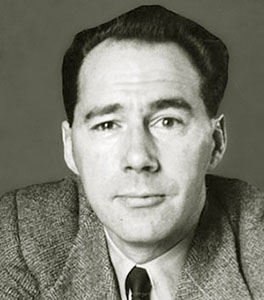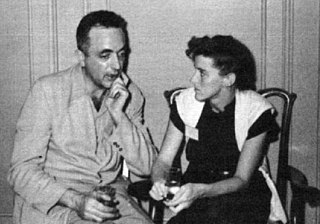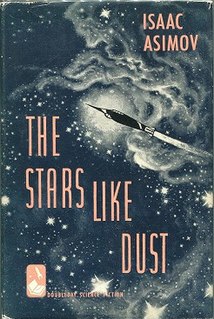
Cyril M. Kornbluth was an American science fiction author and a member of the Futurians. He used a variety of pen-names, including Cecil Corwin, S. D. Gottesman, Edward J. Bellin, Kenneth Falconer, Walter C. Davies, Simon Eisner, Jordan Park, Arthur Cooke, Paul Dennis Lavond, and Scott Mariner. The "M" in Kornbluth's name may have been in tribute to his wife, Mary Byers; Kornbluth's colleague and collaborator Frederik Pohl confirmed Kornbluth's lack of any actual middle name in at least one interview.

John Wyndham Parkes Lucas Beynon Harris was an English science fiction writer best known for his works published under the pen name John Wyndham, although he also used other combinations of his names, such as John Beynon and Lucas Parkes. Some of his works were set in post-apocalyptic landscapes. His best known works include The Day of the Triffids (1951), filmed in 1962, and The Midwich Cuckoos (1957), filmed in 1960 as Village of the Damned and again in 1990 under the same title. In 2022 the book was adapted for a seven episode series for Sky Max under its original title.

Katherine Anne MacLean was an American science fiction author best known for her short fiction of the 1950s which examined the impact of technological advances on individuals and society.

The Three Stigmata of Palmer Eldritch is a 1965 science fiction novel by American writer Philip K. Dick. It was nominated for the Nebula Award for Best Novel in 1965. Like many of Dick's novels, it utilizes an array of science fiction concepts and explores the ambiguous slippage between reality and unreality. It is one of Dick's first works to explore religious themes.

The Foundation series is a science fiction book series written by American author Isaac Asimov. First published as a series of short stories in 1942–50, and subsequently in three collections in 1951–53, for thirty years the series was a trilogy: Foundation; Foundation and Empire; and Second Foundation. It won the one-time Hugo Award for "Best All-Time Series" in 1966. Asimov began adding new volumes in 1981, with two sequels: Foundation's Edge and Foundation and Earth, and two prequels: Prelude to Foundation and Forward the Foundation. The additions made reference to events in Asimov's Robot and Empire series, indicating that they also were set in the same fictional universe.

Pebble in the Sky is a science fiction novel by American writer Isaac Asimov, published in 1950. This work is his first novel — parts of the Foundation series had appeared from 1942 onwards in magazines, but Foundation was not published in book form until 1951. The original Foundation books are also a string of linked episodes, whereas this is a complete story involving a single group of characters.

Robert Silverberg is an American author and editor, best known for writing science fiction. He is a multiple winner of both Hugo and Nebula Awards, a member of the Science Fiction and Fantasy Hall of Fame, and a Grand Master of SF. He has attended every Hugo Awards ceremony since the inaugural event in 1953.
John Dann MacDonald was an American writer of novels and short stories. He is known for his thrillers.

The Stars, Like Dust is a 1951 science fiction mystery book by American writer Isaac Asimov.

The Currents of Space is a science fiction novel by the American writer Isaac Asimov, published in 1952. It is the second of three books labeled the Galactic Empire series, but it was the last of the three to be written. Each occurs after humans have settled many worlds in the galaxy, after the second wave of colonization that went beyond the Spacer worlds, and before the era of decline that was the setting for the original Foundation series.

The Skylark of Space is a science fiction novel by American writer Edward E. "Doc" Smith, written between 1915 and 1921 while Smith was working on his doctorate. Though the original idea for the novel was Smith's, he co-wrote the first part of the novel with Lee Hawkins Garby, the wife of his college classmate and later neighbor Carl Garby. The novel starts as an edisonade, but turns into a space travel adventure when the characters go into deep space. The Skylark of Space is considered to be one of the earliest novels of interstellar travel and the first example of space opera. Originally serialized in 1928 in the magazine Amazing Stories, it was first published in book form in 1946 by the Buffalo Book Co. The novel was followed by three sequels, beginning with Skylark Three.

Against the Fall of Night is a science fiction novel by British writer Arthur C. Clarke. Originally appearing as a novella in the November 1948 issue of the magazine Startling Stories, it was revised and expanded in 1951 and published in book form in 1953 by Gnome Press. It was later expanded and revised again and published in 1956 as The City and the Stars. A later edition includes another of Clarke's early works and is titled The Lion of Comarre and Against the Fall of Night. In 1990, with Clarke's approval, Gregory Benford wrote a sequel titled Beyond the Fall of Night, which continues the story arc of the 1953 novel. It is generally printed with the original novel as a single volume.

The Sands of Mars is a science fiction novel by English writer Arthur C. Clarke. While he was already popular as a short story writer and as a magazine contributor, The Sands of Mars was also a prelude to Clarke's becoming one of the world's foremost writers of science fiction novels. The story was published in 1951, before humans had achieved space flight. It is set principally on the planet Mars, which has been settled by humans and is used essentially as a research establishment. The story setting is that Mars has been surveyed but not fully explored on the ground. The Sands of Mars was Clarke's first published novel.

The literary genre of science fiction is diverse, and its exact definition remains a contested question among both scholars and devotees. This lack of consensus is reflected in debates about the genre's history, particularly over determining its exact origins. There are two broad camps of thought, one that identifies the genre's roots in early fantastical works such as the Sumerian Epic of Gilgamesh. A second approach argues that science fiction only became possible sometime between the 17th and early 19th centuries, following the scientific revolution and major discoveries in astronomy, physics, and mathematics.
The science fiction writer Robert A. Heinlein (1907–1988) was productive during a writing career that spanned the last 49 years of his life; the Robert A. Heinlein bibliography includes 32 novels, 59 short stories and 16 collections published during his life. Four films, two TV series, several episodes of a radio series, at least one song and a board game derive more or less directly from his work. He wrote a screenplay for one of the films. Heinlein edited an anthology of other writers' science fiction short stories.
The Heinlein juveniles are the science fiction novels written by Robert A. Heinlein for Scribner's young-adult line. Each features "a young male protagonist entering the adult world of conflict, decisions, and responsibilities." Together they tell a loosely-connected story of space exploration. Scribner's published the first twelve between 1947 and 1958, but rejected the thirteenth, Starship Troopers. That one was instead published by Putnam. A fourteenth novel, Podkayne of Mars, is sometimes listed as a "Heinlein juvenile", although Heinlein himself did not consider it to be one.

Rogue Queen is a science fiction novel by American writer L. Sprague de Camp, the third book in his Viagens Interplanetarias series. It was first published in hardcover by Doubleday in 1951, and in paperback by Dell Books in 1952. A later hardcover edition was issued by The Easton Press in its The Masterpieces of Science Fiction series in 1996; later paperback editions were issued by Ace Books (1965) and Signet Books. A trade paperback edition was issued by Bluejay Books in June 1985. The first British edition was published in paperback by Pinnacle Books in 1954; a British hardcover reprint followed from Remploy in 1974. The novel has been translated into Portuguese, Italian, French and German. An E-book edition was published by Gollancz's SF Gateway imprint on September 29, 2011 as part of a general release of de Camp's works in electronic form. Arc Manor's Phoenix Pick imprint reissued the book in both trade paperback and e-book format in January 2012.

The Viagens Interplanetarias series is a sequence of science fiction stories by L. Sprague de Camp, begun in the late 1940s and written under the influence of contemporary space opera and sword and planet stories, particularly Edgar Rice Burroughs's Martian novels. Set in the future in the 21st and 22nd centuries, the series is named for the quasi-public Terran agency portrayed as monopolizing interstellar travel, the Brazilian-dominated Viagens Interplanetarias. It is also known as the Krishna series, as the majority of the stories belong to a sequence set on a fictional planet of that name. While de Camp started out as a science fiction writer and his early reputation was based on his short stories in the genre, the Viagens tales represent his only extended science fiction series.

The Listeners is a 1972 science fiction novel by American author James Gunn. It centers on the search for interstellar communication and the effect that receipt of a message has. Although the search and the message are the unifying background of the novel, the chapters explore the personal effect of these events have on the lives of the characters.

Ballroom of the Skies is a 1952 science fiction novel by American writer John D. MacDonald. Though MacDonald was primarily a mystery novelist famed for his Travis McGee series, he did write some science fiction short stories and novels. Other titles include Wine of the Dreamers (1951) and The Girl, the Gold Watch & Everything (1962).

















